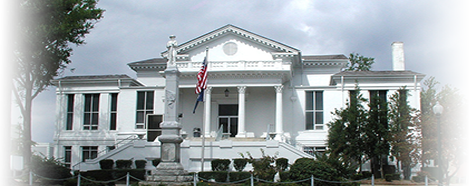|
A Brief History of the County of Laurens
The original inhabitants of Laurens County were the Cherokee Indians. The first known European in the area was John Duncan, a native of Aberdeen, Scotland, who came from Pennsylvania in 1753 and settled near the modern Newberry-Laurens County line. He liked the lush vegetation and abundant wildlife he found in this area, and he settled along a creek in the northeastern section of the county, not far from the present City of Clinton. Duncan brought the first African-American slave and the first horse-drawn wagon to the area. Duncan's settlement grew and by the mid 1760's a church was established that became known as Duncan's Creek Presbyterian Church, the oldest church in Laurens County.
Four important Revolutionary Battles took place in Laurens County. On July 15, 1776, patriot forces defeated a combines Indian and Tory attack on Lyndley's Fort near Rabun Creek. At the Battle of Musgrove's Mill on August 18, 1780, a force of rebels attacked the British and Tory forces achieving a decisive victory in the two-day battle. On December 29, 1780, a Tory detachment was defeated at Hammond's Store near present-day Clinton. Near the end of the ware, at Hayes Station (eight miles southwest of Clinton) Captain "Bloody Bill" Cunningham attacked a contingent of rebels slaughtering fourteen. After the Revolutionary War, the Ninety-Six District became the chief governmental unit of the backcountry. In 1785, Laurens County, named for statesman Henry Laurens of Charleston, was one of six counties carved from the district. To select a site for the county seat, a delegation met at the distillery of John Rodgers, near the present Laurens Courthouse Square. Tradition has it that the men, after imbibing freely, climbed the hill to a level area and chose the spot for the courthouse. More likely, the site was selected for its close proximately to water and because five important roads connecting the upcountry converged at the point. A wooden courthouse, also used as a church and a schoolhouse, was constructed shortly afterwards. An improved courthouse was built between during 1837 and 1838 and subsequently enlarged in 1857 and 1911. After the Revolution, the upcountry saw immigrant arrive from Pennsylvania seeking cheap land. By 1800, the population of Laurens County stood at 12, 809 of which almost eighty-five percent were white. However, as cotton production expended throughout the antebellum period, the number of slaves in Laurens increase accordingly. Laurens County produced almost 16, 000 bales of cotton in 1850. Ten years later, the county population reached 23, 858, over half of which consisted of slaves. Villages sprang up and briefly thrived during this period at Cross Hill, Waterloo, Princeton , Gray Court, Owings, Ora and Mountville. However, they gradually dwindled with Laurens and Clinton became the dominant towns in the county. The General Assembly passed an act on March 12, 1785, whereby 6 counties were to be established out of the old Ninety-Six District. Laurens County was one of those counties. The county of Laurens owes its beautiful location to John Rogers, Charles Allen, Jonathan Downes, and others who were deputized by the fourteenth and fifty-first regiments of SC to lay a town. Laurens County derived its name from a patriot, warrior, and statesman, --the Honorable Henry Laurens of Charleston. Henry Laurens was president of the Continental Congress during the Revolutionary War, and later served as an ambassador to France to secure aid in helping the colonies with their independence. Scotch-Irish immigrants out of Pennsylvania, Maryland, and Virginia became the predominate settlers of the county. The town of Laurens (known as Laurensville well into the nineteenth century) became the county seat and the first courthouse was erected in 1786. The current courthouse was built in 1840 and enlarged in 1857. By 1820, Laurens had become known for its trade of tailor-made clothes. Andrew Johnson, a future president of the United States, and his brother came to Laurens in 1824 and established a tailor shop. By 1840, the area was booming with establishments, including medical practitioners, a fancy confectionery and fruit store, carriage, buggy and wagon shops, tailoring establishments, building contractors, flour and corn mills, and 81 registered whiskey distilleries. For more about Laurens County click here. |

